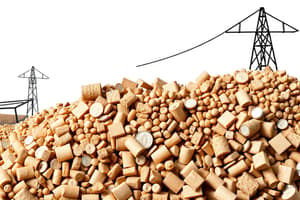Podcast
Questions and Answers
______ supply represents the total quantity of goods and services that firms are willing and able to produce at various price levels within an economy during a specific period.
______ supply represents the total quantity of goods and services that firms are willing and able to produce at various price levels within an economy during a specific period.
Aggregate
Higher ______, without corresponding increases in productivity, can lead to increased costs for firms, potentially shifting the AS curve to the left.
Higher ______, without corresponding increases in productivity, can lead to increased costs for firms, potentially shifting the AS curve to the left.
wages
______ rates impact the cost of borrowing for firms; higher ones increase the cost of financing investments and operations.
______ rates impact the cost of borrowing for firms; higher ones increase the cost of financing investments and operations.
Interest
Stricter environmental regulations or higher corporate taxes may increase compliance costs, thereby reducing ______ supply.
Stricter environmental regulations or higher corporate taxes may increase compliance costs, thereby reducing ______ supply.
______ advancements enhance productivity and efficiency, enabling firms to produce more goods and services with the same amount of inputs.
______ advancements enhance productivity and efficiency, enabling firms to produce more goods and services with the same amount of inputs.
Investment in ______ capital, such as machinery and equipment, expands an economy's productive capacity, shifting the AS curve to the right.
Investment in ______ capital, such as machinery and equipment, expands an economy's productive capacity, shifting the AS curve to the right.
______ capital refers to the skills, knowledge, and experience of the workforce, improved through investments in education and training.
______ capital refers to the skills, knowledge, and experience of the workforce, improved through investments in education and training.
An increase in the ______ force, through population growth or increased participation, can expand an economy's productive capacity.
An increase in the ______ force, through population growth or increased participation, can expand an economy's productive capacity.
______ policies, including tax policies and infrastructure development, can significantly impact the incentives and ability of firms to produce.
______ policies, including tax policies and infrastructure development, can significantly impact the incentives and ability of firms to produce.
______ drives innovation and efficiency; entrepreneurs create new businesses, adopt new technologies, and improve production processes.
______ drives innovation and efficiency; entrepreneurs create new businesses, adopt new technologies, and improve production processes.
______ factors encompass the legal, regulatory, and political environment, which can foster or hinder investment and production.
______ factors encompass the legal, regulatory, and political environment, which can foster or hinder investment and production.
The short-run aggregate supply (SRAS) curve is typically upward sloping because some input costs are ______ in the short term.
The short-run aggregate supply (SRAS) curve is typically upward sloping because some input costs are ______ in the short term.
In the short run, wages and prices are often ______, meaning they do not immediately adjust to changes in the price level.
In the short run, wages and prices are often ______, meaning they do not immediately adjust to changes in the price level.
The long-run aggregate supply (LRAS) curve is ______ at the potential output level.
The long-run aggregate supply (LRAS) curve is ______ at the potential output level.
Changes in aggregate demand only affect the ______ level in the long run, not the level of output.
Changes in aggregate demand only affect the ______ level in the long run, not the level of output.
An increase in AS is represented by a ______ shift of the AS curve, indicating greater productivity and capacity.
An increase in AS is represented by a ______ shift of the AS curve, indicating greater productivity and capacity.
A decrease in AS is shown by a ______ shift of the AS curve, which can be caused by rising input costs or supply shocks.
A decrease in AS is shown by a ______ shift of the AS curve, which can be caused by rising input costs or supply shocks.
Exchange rates influence the cost of ______ inputs; a weaker domestic currency increases these costs, potentially reducing aggregate supply.
Exchange rates influence the cost of ______ inputs; a weaker domestic currency increases these costs, potentially reducing aggregate supply.
Natural ______ available to an economy, such as minerals and oil, can significantly influence its productive capacity and aggregate supply.
Natural ______ available to an economy, such as minerals and oil, can significantly influence its productive capacity and aggregate supply.
______ costs, particularly electricity and fuel, are critical for production and transportation, with higher prices potentially reducing aggregate supply.
______ costs, particularly electricity and fuel, are critical for production and transportation, with higher prices potentially reducing aggregate supply.
Flashcards
Aggregate Supply (AS)
Aggregate Supply (AS)
Total quantity of goods/services firms produce at different price levels in an economy during a period.
Costs of Production
Costs of Production
Wages, raw material prices, energy costs, and interest rates all impact production costs.
Impact of Higher Wages
Impact of Higher Wages
Higher wages increase firm costs potentially shifting the AS curve to the left.
Raw Material Prices
Raw Material Prices
Signup and view all the flashcards
Interest Rates
Interest Rates
Signup and view all the flashcards
Government Regulations and Taxes
Government Regulations and Taxes
Signup and view all the flashcards
Exchange Rates
Exchange Rates
Signup and view all the flashcards
Technological Advancements
Technological Advancements
Signup and view all the flashcards
Investment in Physical Capital
Investment in Physical Capital
Signup and view all the flashcards
Human Capital
Human Capital
Signup and view all the flashcards
Government Policies
Government Policies
Signup and view all the flashcards
Entrepreneurship
Entrepreneurship
Signup and view all the flashcards
Institutional Factors
Institutional Factors
Signup and view all the flashcards
Short-Run Aggregate Supply (SRAS)
Short-Run Aggregate Supply (SRAS)
Signup and view all the flashcards
Long-Run Aggregate Supply (LRAS)
Long-Run Aggregate Supply (LRAS)
Signup and view all the flashcards
Increase in Aggregate Supply
Increase in Aggregate Supply
Signup and view all the flashcards
Decrease in Aggregate Supply
Decrease in Aggregate Supply
Signup and view all the flashcards
Study Notes
- Aggregate supply (AS) represents the total quantity of goods and services that firms are willing and able to produce at various price levels within an economy during a specific period.
- It is a crucial concept in macroeconomics, influencing key indicators such as GDP, employment, and inflation.
- The factors influencing aggregate supply growth are pivotal for long-term economic prosperity and stability.
Determinants of Aggregate Supply
- The position of the AS curve is primarily determined by the costs of production and productive capacity.
Costs of Production
- Wages and salaries are a significant component of production costs.
- Higher wages, without corresponding increases in productivity, lead to increased costs for firms, potentially shifting the AS curve to the left (decrease in supply).
- Raw material prices directly affect production costs.
- Increases in the prices of commodities like oil, metals, and agricultural products raise costs for businesses, reducing profitability and potentially decreasing aggregate supply.
- Energy costs, particularly electricity and fuel, are critical for production and transportation.
- Higher energy prices increase operational costs, which can lead to a reduction in AS.
- Interest rates impact the cost of borrowing for firms.
- Higher interest rates increase the cost of financing investments and operations, potentially discouraging production and shifting the AS curve to the left.
- Government regulations and taxes can impose costs on businesses.
- Stricter environmental regulations or higher corporate taxes may increase compliance costs, thereby reducing AS.
- Exchange rates influence the cost of imported inputs.
- A weaker domestic currency increases the cost of imported raw materials and components, potentially reducing aggregate supply.
Factors Influencing Growth of Aggregate Supply
- Technological advancements enhance productivity and efficiency.
- Innovations in production processes, automation, and information technology enable firms to produce more goods and services with the same amount of inputs, leading to an increase in AS.
- Investment in physical capital, such as machinery, equipment, and infrastructure, expands an economy's productive capacity.
- Increased capital stock allows firms to produce more efficiently, leading to a rightward shift in the AS curve.
- Human capital refers to the skills, knowledge, and experience of the workforce.
- Investments in education, training, and healthcare improve the quality of labor, enhancing productivity and increasing AS.
- The size and quality of the labor force are critical determinants of AS.
- An increase in the labor force, whether through population growth or increased labor force participation, can expand an economy's productive capacity.
- Government policies play a crucial role in shaping aggregate supply.
- Tax policies, regulations, infrastructure development, and trade policies can significantly impact the incentives and ability of firms to produce goods and services.
- Natural resources available to an economy can influence its productive capacity.
- The abundance of natural resources such as minerals, oil, and arable land can support industries and contribute to AS.
- Entrepreneurship drives innovation and efficiency.
- Entrepreneurs create new businesses, adopt new technologies, and improve production processes, all of which can boost AS.
- Institutional factors encompass the legal, regulatory, and political environment.
- Strong property rights, contract enforcement, and political stability create a conducive environment for investment and production, fostering growth in AS.
Short-Run vs. Long-Run Aggregate Supply
- The short-run aggregate supply (SRAS) curve is typically upward sloping because some input costs are fixed in the short term.
- In the short run, wages and prices are often sticky, meaning they do not immediately adjust to changes in the price level.
- The long-run aggregate supply (LRAS) curve is vertical at the potential output level.
- It represents the economy's maximum sustainable output, determined by its available resources, technology, and institutions.
- Changes in aggregate demand only affect the price level in the long run, not the level of output.
Shifts in Aggregate Supply
- An increase in AS is represented by a rightward shift of the AS curve.
- This can result from technological advancements, increased investment, improvements in human capital, or other factors that enhance productivity and capacity.
- A decrease in AS is shown by a leftward shift of the AS curve.
- This can be caused by rising input costs, adverse supply shocks (e.g., natural disasters), or contraction in the labor force.
Studying That Suits You
Use AI to generate personalized quizzes and flashcards to suit your learning preferences.




